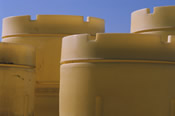
Containers holding hazardous waste must be closed at all times, except when adding or removing waste. The container may not be stored, handled, or opened in any way that would cause it to leak or rupture (e.g., the containers should not be stacked vertically).
Weekly Inspections
All containers and container areas must be inspected at least weekly to determine if there are any leaking containers or deterioration of containers and the containment system caused by corrosion or other conditions. If a leak or container deterioration is found, immediate action is required. TSDFs must keep records of inspections in a log or summary for 3 years following the date of inspection. Many experts, however, believe it is a good practice to keep all facility records for at least 5 years.
Note: Although generators must comply with the weekly inspection requirement, they are not required to record the inspections in a log or summary. It would be prudent, however, for generators to maintain such a log or summary. Some states explicitly require a log or summary in their regulations for generators.
Environmental Compliance in [Your State] gives you expert analysis of your state environmental regulations, along with instant comparisons between federal and state environmental protection agency regulations. Every key 40 CFR topic is at your fingertips. Get Your Free Trial
Containers Sent to TSDFs
The air emissions standards for containers require the TSDF owner or operator receiving a container to visually inspect the container, its cover, and closure device in the closed position in order to determine that there are no visible openings or gaps through which organics could be emitted. This inspection must occur on or before the date that the container is accepted at the facility. In this context, "accepted" means the date of the facility owner’s, or operator’s signature on Item 20 of the manifest. If, however, the container is to be emptied within 24 hours after being accepted at the TSDF, the visual inspection is not required. If a defect is detected, repairs must commence within 24 hours of detection and be completed no later than 5 days after detection.
State environmental compliance is probably your biggest job challenge—the regulations and laws are so complex and they change so fast! Take a free trial of Environmental Compliance in [Your State] and see why thousands of companies have relied on the Environmental “Red Book” for over 16 years. Get Your Free Trial
Adding Absorbent Material
TSDF owners or operators and generators that wish to add absorbent material to their containers of hazardous waste can do so without such actions constituting treatment (and therefore requiring a permit) if they comply with 40 CFR 264.1(g)(10) or 40 CFR 265.1(c)(13), as applicable. These rules require that the addition of absorbent material to waste in a container or the addition of waste to absorbent material in a container occur at the time waste is first placed in the container. In addition, the container must be in good condition and compatible with the waste and the absorbent material. If the facility treats, stores, or disposes ignitable or reactive waste, or mixes incompatible waste or incompatible waste and other materials, the facility owner or operator must comply with the general requirements for ignitable, reactive, or incompatible wastes.
See this Environmental Daily Advisor Article on the most common container violations.
Tomorrow’s Advisor will highlight best management practices for reusing 55-gallon drums.
